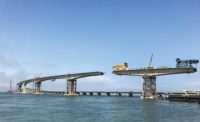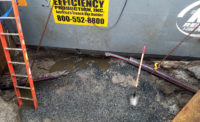Having successfully helped to restore power to two North Carolina barrier islands, PCL Civil Constructors now faces the fallout from a July 27 construction incident that forced a week-long evacuation of 60,000 visitors, putting a potential multimillion-dollar dent in the region’s tourism-dependent economy.
At least two class-action lawsuits have been filed against the Denver-based contractor and its affiliated companies by local businesses, rental property owners and individuals seeking compensation for losses sustained after a steel casing was driven into a buried, three-cable 115kV power transmission line at the site of the new Bonner Bridge across Oregon Inlet.
The disruption left Hatteras and Ocracoke islands in the dark at the peak of tourist season, forcing an immediate evacuation of non-residents.
The disruption left Hatteras and Ocracoke islands in the dark at the peak of tourist season, forcing an immediate evacuation of non-residents. Preliminary estimates from Dare County officials put economic losses to Hatteras Island alone at approximately $2 million per day.
One action, filed in U.S. District Court for Eastern North Carolina, accuses PCL of sacrificing safety for cost savings by failing to follow “proper risk management practices” to safeguard the transmission line from damage.
According to the court filing, the project team’s “cost-cutting measures were taken with willful, wanton, and reckless indifference to the economic interests, businesses, and property” of the lawsuit’s plaintiffs and class members.
Relocated in December 2015 in advance of the $246-million bridge project, the transmission line was buried 7 to 9 ft underground for several hundred feet between an oceanside conduit attached to the existing bridge and a series of riser poles at the northern tip of Hatteras.
According to the North Carolina Dept. of Transportation, the casing struck the cable as it was being placed for temporary storage during a routine pre-dawn cleanup operation.
NCDOT also confirmed that the new location of the transmission line, owned by the Cape Hatteras Electric Cooperative (CHEC), was noted on project plans. However, it is unclear whether there were any corresponding surface markings.
Robert Harris, transmission and distribution engineer for the National Rural Electric Cooperative Association, says that while some type of marker is usually used to identify the location of underground power lines in construction areas, “the type and distance can vary.”
Excavation revealed that one of the transmission cables was completely severed, with a second sufficiently compromised to require repair. The third cable was undamaged.
High Water Table Slowed Power Restoration Effort
Because the site’s high water table slowed efforts to safely access and resplice the damaged cables, CHEC initiated construction of a nine-span overhead transmission line between the bridge and the existing riser pole. The new line was fully tested and energized on Aug. 3, a week after the disruption occurred. Visitors were allowed to return the next day.
A CHEC spokesperson says the overhead line will remain in place at least until the new bridge is completed, currently scheduled for 2019.
After power was restored, PCL announced via social media that it was “working to provide assistance to those affected” by the outage and published a downloadable claim form that applicants could submit to Crawford & Co., an Atlanta-based claims management provider.
Attorney Harper Heckman, chair of the construction law practice at Nexsen Pruet, Greensboro, N.C., expects PCL’s general liability insurance will cover what likely will be a significant volume of claims, ranging from spoiled food and forfeited vacation rental deposits to business-interruption losses.
PCL’s potential liability could have been far more substantial had the outage lasted several weeks, as originally feared, Heckman says, adding, “This will be a smaller-scale version of … the Deepwater Horizon spill … [which] affected tourism businesses along the Gulf Coast.”
Following that 2010 event, BP paid claimants in the restaurant and hotel sectors more than $1.3 billion, according to the U.S. Dept. of the Interior.






Post a comment to this article
Report Abusive Comment